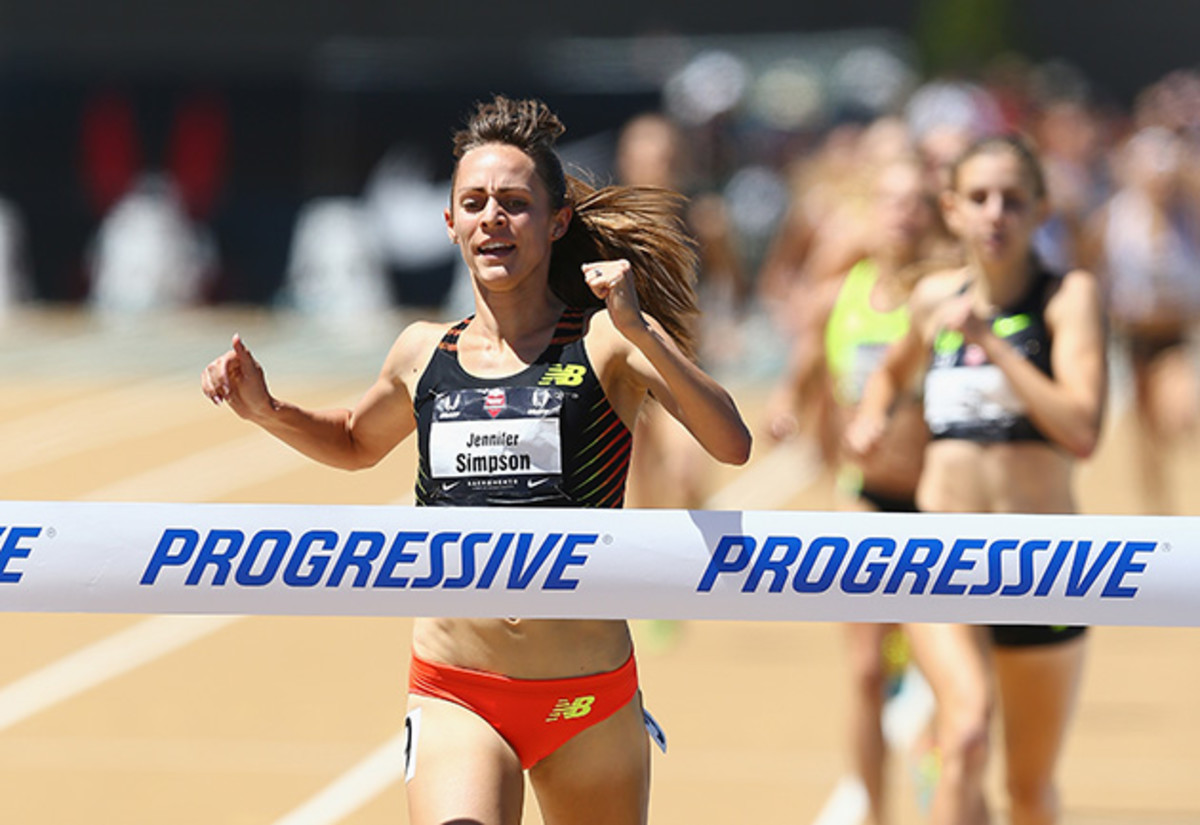Jenny Simpson hits her stride as U.S. distance running’s new leader

Jenny Simpson watched the 2004 women’s Olympic marathon on television. She was 17 then and still Jenny Barringer, an eight-time Florida state champion in track and cross-country who was about to head off to run at Colorado. Watching U.S. marathoner Deena Kastor win bronze in Athens struck a powerful chord.
“It was inspiring to see [an American woman] medaling at the Olympics,” Simpson says. “It was a poignant moment for a lot of high school distance women my age.”
Simpson would make her first Olympic team four years later in the steeplechase. At those Beijing Games she roomed with Shalane Flanagan, a former star at North Carolina who earned a bronze in the 10,000 meters. “I saw Shalane as a very recent graduate from college, and I was in college,” Simpson says. “I thought, If this woman could do it, I could do it.”
In the seven years since, Simpson, 28, has indeed done it, surging to the front of an increasingly strong field of American women distance runners. In 2009 she broke four minutes, a benchmark for elite status, in the 1,500 for the first time, and in ’11 she won the world championship at that distance. She followed that up with a silver at the ’13 worlds, and last season at a Diamond League meet she set a new personal best of 3:57.22, .10 of a second off Mary Slaney’s32-year-old U.S. record. Simpson finished the season ranked No. 1 in the world.
“When one person does something it can really open the floodgates,” says Simpson, who is hardly alone in making a name for herself on the track. This season she is just one of a record eight American women who have run under 4:05 for the 1,500. In the steeplechase 24-year-old Emma Coburn has emerged as a medal contender, while in the 800 the depth is so great that Lauren Wallace failed to qualify for the final at June’s U.S. championships despite running the world-class time of 2:00.48.

Even among all those talented competitors, Simpson stands out. Her goals this season include winning the world championship in August in Beijing and, at some point, making another run at Slaney’s record. “If I’m in a situation where the race is going well, that record can really come,” says Simpson. “I feel more ready for it now than I was last year.”
In the Running
With the world track and field championships set for Aug. 22–30 and the Olympics barely a year away, several other U.S. women are making strides on the international scene. —Richard O’Brien
Emma Coburn, 24
Another Colorado grad and 2012 Olympian, Coburn is the reigning U.S. steeplechase champ. World-ranked No. 3 in ’14, she’s a medal favorite for Beijing.
Molly Huddle, 30
The Notre Dame alum holds the U.S. record at 5,000 meters and stepped up to the 10,000 this season. She beat Flanagan to win the U.S. title on June 25, securing a world championship berth.
Ajeé Wilson, 21
The Neptune, N.J., 800-meter specialist won the 2012 world junior championships. Her PR of 1:57.67 at a Diamond League event was fastest in the world in ’14.
For any competitive runner, racing season is the reward for (and point of) all that hard training, but it also brings unique challenges. With experience, Simpson has learned what works for her when it comes to maintaining her health and fitness while traveling and competing at the highest level.
“When I’m on the road, I have to manage the stress and fatigue that comes with flying, hotel living, eating different food, and being away from the comfort of my home and regular routine,” she says. “Plus, in the thick of my racing season, the truth is that most of the hard work and training sessions are already in the bank, so I shift my focus from tough training and reallocate that energy into recovery and injury-prevention.”
Simpson’s key recommendations:
Going the extra mile: Can long distance running lead to arthritis?
Eat smart: “I pack familiar snacks that I know will digest easily and I grab fruit from breakfast so that I have something to eat throughout the day. It’s important to me to keep my regular eating rhythm from home going while I’m on the road, and that means lighter meals with snacks in between. Getting out of that rhythm often leads to an upset stomach—which can, unfortunately, force an interruption to training.”
Plan your rest: “Nothing can replace a good night of sleep. Sleeping only a few hours each night for several nights in a row can be a disaster for your mind and body when you’re trying to perform at your peak. I often travel with a specific pillow and I try to keep my hotel room cool. I also make sure to do a regular wind-down routine in the evening.”
Don’t try to do too much: “When I was a lot younger and traveling to big races for the first time I had a serious case of ‘Fear of Missing Out.’ I wanted to experience everything, try different foods, and visit new places. I think it’s truly edifying to take advantage of new experiences that the sport affords an athlete, but I’ve learned to take it all in moderation. I still visit museums, eat at local restaurants, and participate in activities surrounding the track meets. The difference is that I don’t try to do it all. Even if I might not be back to the same race or the same city, I appreciate what I was able to do and move on to the next adventure.”
Keep working: “Races are the hardest workout, but they cannot be theonly workout. I make sure I can get onto a good track and put my spikes on for workouts between races, otherwise my fitness will begin to slip away. Good sleep has to be a priority especially when adjusting to big time changes.”
